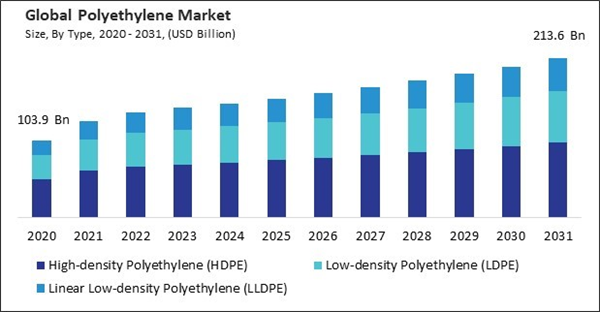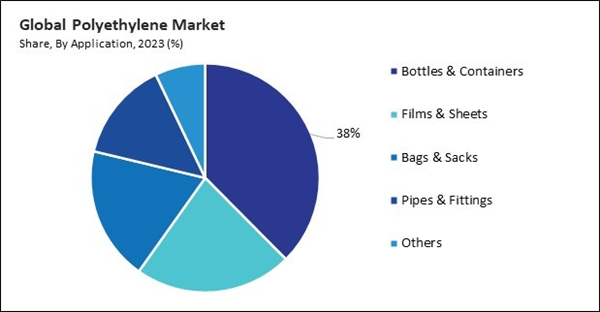The Global Polyethylene Market size is expected to reach $213.6 billion by 2031, rising at a market growth of 4.9% CAGR during the forecast period. In the year 2023, the market attained a volume of 1,04,899.1 kilo tonnes, experiencing a growth of 16.9% (2020-2023).
Automakers increasingly focus on reducing vehicle weight to improve fuel efficiency and reduce emissions. Thus, the automotive segment acquired 10.3% revenue share in the market 2023. In the terms of volume, the automotive segment would attain a volume of 14,841.3 kilo tonnes by 2031. Polyethylene, particularly high-density polyethylene (HDPE) and low-density polyethylene (LDPE) is valued for its lightweight properties compared to traditional materials such as metal and glass. Automakers can achieve significant weight savings by replacing heavier materials with polyethylene components without compromising vehicle performance or safety.
As consumer lifestyles evolve and urbanization rates rise globally, there is a parallel increase in the consumption of packaged goods. These goods range from food and beverages to personal care products, pharmaceuticals, and household items. Polyethylene is a preferred material for packaging due to its versatility, durability, lightweight nature, and cost-effectiveness.
Additionally, automakers increasingly focus on lightweight vehicles to improve fuel efficiency, reduce emissions, and enhance performance. Polyethylene's lightweight nature, strength, and durability make it an attractive material for automotive components such as interior trim, bumpers, door panels, and under-the-hood parts.
However, polyethylene is primarily derived from petroleum feedstocks, such as ethylene and propylene, which are byproducts of crude oil and natural gas processing. As a result, the cost of raw materials accounts for a significant portion of the production costs for polyethylene manufacturers. Hence, volatility in raw material prices is hampering the market's growth.
Automakers increasingly focus on reducing vehicle weight to improve fuel efficiency and reduce emissions. Thus, the automotive segment acquired 10.3% revenue share in the market 2023. In the terms of volume, the automotive segment would attain a volume of 14,841.3 kilo tonnes by 2031. Polyethylene, particularly high-density polyethylene (HDPE) and low-density polyethylene (LDPE) is valued for its lightweight properties compared to traditional materials such as metal and glass. Automakers can achieve significant weight savings by replacing heavier materials with polyethylene components without compromising vehicle performance or safety.
As consumer lifestyles evolve and urbanization rates rise globally, there is a parallel increase in the consumption of packaged goods. These goods range from food and beverages to personal care products, pharmaceuticals, and household items. Polyethylene is a preferred material for packaging due to its versatility, durability, lightweight nature, and cost-effectiveness.
Additionally, automakers increasingly focus on lightweight vehicles to improve fuel efficiency, reduce emissions, and enhance performance. Polyethylene's lightweight nature, strength, and durability make it an attractive material for automotive components such as interior trim, bumpers, door panels, and under-the-hood parts.
However, polyethylene is primarily derived from petroleum feedstocks, such as ethylene and propylene, which are byproducts of crude oil and natural gas processing. As a result, the cost of raw materials accounts for a significant portion of the production costs for polyethylene manufacturers. Hence, volatility in raw material prices is hampering the market's growth.
Type Outlook
Based on type, the market is divided into low-density polyethylene (LDPE), high-density polyethylene (HDPE), and linear low-density polyethylene (LLDPE). In 2023, the high-density polyethylene (HDPE) segment garnered 48.5% revenue share in the polyethylene market. In the terms of volume, the HPDE segment would attain a volume of 67,864.6 kilo tonnes by 2029.HDPE is utilized in various industrial applications, such as corrosion-resistant linings for tanks and pipes, chemical storage containers, and industrial packaging.Application Outlook
On the basis of application, the market is segmented into bottles & containers, films & sheets, bags & sacks, pipes & fittings, and others. The bags & sacks segment held 18.9% growth rate in the market in 2023. In the terms of volume bags & sacks segment would attain a volume of 28,700.5 kilo tonnes by 2030. Polyethylene bags and sacks are extensively used in agriculture for packaging, storage, and transportation of seeds, fertilizers, pesticides, and harvested crops.END-USE Outlook
Based on end-use, the market is categorized into packaging, construction, automotive, agriculture, consumer electronics, and others. In 2023, the packaging segment registered 50.2% revenue share in the polyethylene market. Polyethylene is an incredibly versatile material that can be tailored to meet the specific requirements of various packaging applications.Regional Outlook
Region-wise, the market is analyzed across North America, Europe, Asia Pacific, and LAMEA. The North America region generated 21.3% revenue share in the polyethylene market. In the terms of volume, the North America region would attain a volume of 32,317.3 kilo tonnes by 2031.North America is home to a diverse range of manufacturing and industrial sectors that rely heavily on polyethylene for packaging, construction, automotive, consumer goods, and other applications.List of Key Companies Profiled
- BASF SE
- SABIC (Saudi Arabian Oil Company)
- Borealis AG (OMV)
- Braskem S.A. (Odebrecht S.A)
- The Dow Chemical Company
- Exxon Mobil Corporation
- Formosa Plastics Group
- INEOS Group Holdings S.A.
- Mitsubishi Chemical Holdings Corporation
- Sinopec Group (China Petrochemical Corporation)
Market Report Segmentation
By Type (Volume, Kilo Tonnes, USD Billion, 2020-2031)
- High-density Polyethylene (HDPE)
- Low-density Polyethylene (LDPE)
- Linear Low-density Polyethylene (LLDPE)
By Application (Volume, Kilo Tonnes, USD Billion, 2020-2031)
- Bottles & Containers
- Films & Sheets
- Bags & Sacks
- Pipes & Fittings
- Others
By End-Use (Volume, Kilo Tonnes, USD Billion, 2020-2031)
- Packaging
- Construction
- Automotive
- Agriculture
- Consumer Electronics
- Others
By Geography (Volume, Kilo Tonnes, USD Billion, 2020-2031)
- North America
- US
- Canada
- Mexico
- Rest of North America
- Europe
- Germany
- UK
- France
- Russia
- Spain
- Italy
- Rest of Europe
- Asia Pacific
- China
- Japan
- India
- South Korea
- Singapore
- Malaysia
- Rest of Asia Pacific
- LAMEA
- Brazil
- Argentina
- UAE
- Saudi Arabia
- South Africa
- Nigeria
- Rest of LAMEA
Table of Contents
Chapter 1. Market Scope & Methodology
Chapter 2. Market at a Glance
Chapter 3. Market Overview
Chapter 4. Global Polyethylene Market by Type
Chapter 5. Global Polyethylene Market by Application
Chapter 6. Global Polyethylene Market by End-use
Chapter 7. Global Polyethylene Market by Region
Chapter 8. Company Profiles
Companies Mentioned
- BASF SE
- SABIC (Saudi Arabian Oil Company)
- Borealis AG (OMV)
- Braskem S.A. (Odebrecht S.A)
- The Dow Chemical Company
- Exxon Mobil Corporation
- Formosa Plastics Group
- INEOS Group Holdings S.A.
- Mitsubishi Chemical Holdings Corporation
- Sinopec Group (China Petrochemical Corporation)
Methodology

LOADING...










